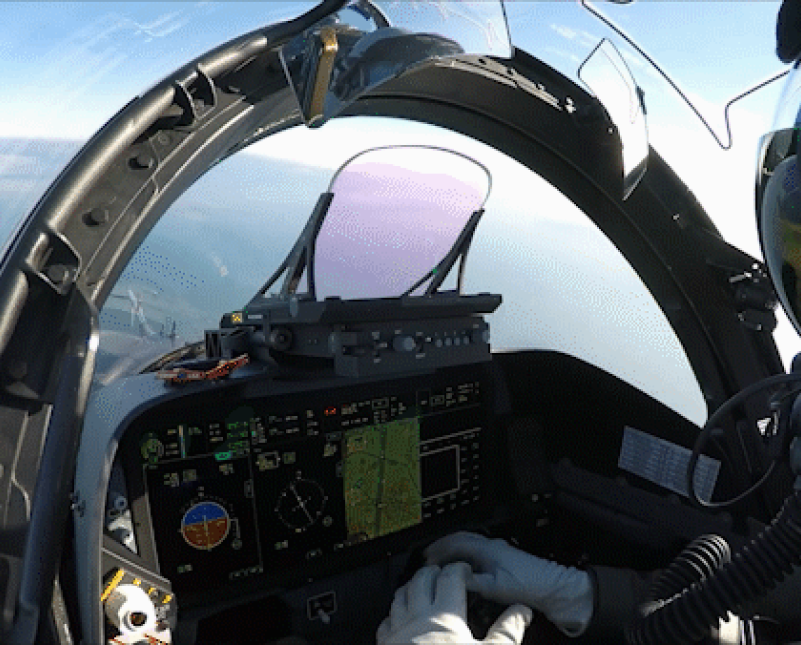
Cockpits have traditionally been filled to the brim with dials, controls, switches and gauges to manage in-flight operations. Today’s cockpits are a little more streamlined, and touchscreen avionics solutions are making it happen.
The “glass cockpits” of today give pilots easy access to all flight-critical controls with the touch of a finger. Operational information is easily categorized and automatically displayed based on the status of the airplane, whether it’s taking-off, cruising, or landing. These solutions also provide pilots with basic necessary operational information such as altitude, airspeed, and vertical speed for efficient flying.
Not surprisingly, a study by the National Transportation Safety Board found that planes equipped with touch screen technology experience fewer incidents. It’s easy to attribute this success with easier access to flight controls and information about the aircraft. Allowing for more knowledge therefore produces an overall safer flying experience.
Touch screens have been implemented in a wide range of uses since the emergence of the revolutionary technology. From personal cell phones and computers to in-store kiosks and even medical machinery, touch technology can be seen in every facet of our lives.
Easy access to multitudes of data about plane operations are available with the touch of a finger, but are utterly useless if the touch avionics solutions aren’t durability tested to the highest standards.
However, it goes a little further than just touch screen technology. Aviation has esoteric concerns that require a touch screen system that goes beyond basic commercial touch solutions. Choosing a system that addresses these concerns requires an in-depth knowledge of how specific features benefit the overall in-flight experience and where safety concerns come into play.
Durability Tested to Military Standards
Primary Flight Displays with all flight information need to remain operational regardless of conditions, which is why touchscreen avionics solutions have to meet military standards, the highest in aviation durability.
In the 1960’s an approximate 40 out of 100,000 plane engines suffered from In-Flight Shut Downs, today only 1 in 100,000 engines fail in-flight. Despite the advances in engine technology and backups, pilots and their surrounding tech must be completely fool-proof in order to be able to correctly monitor their aircraft and immediately react to any situation. Your touch screen solution must meet these same incredibly high standards for durability and enhance your reliability.
Military testing requires strict standards for extreme temperature, humidity, altitude, shock and vibration and must work throughout all of these environments in order to consistently remain functional. Thanks to their redundant architecture, avionics systems are built to withstand shock and vibration so the screen remains on, never losing access to important data.
Sub-10 ms response times and sub-2 mm touch accuracy ensure that every touch point is tracked independently to provide a reliable touch interface. Due to their ability to ignore inputs based on size or shadow, avionics solutions can also be customized to accept inputs from certain materials or sizes, including combat or pilot gloves.
In the case of extreme damage, the best avionics touchscreens should withstand a single point of failure and remain running so as not to interrupt the information needed for pilots to remain on a safe course.
Screen Visible in Any Light
Cockpits are routinely exposed to varying lighting intensities, from extreme brightness to near total darkness. In order for flight operations to remain effective, pilots require a system that is both reliable under any light and doesn’t distract them from their course or interfere in their sightlines. Intuitive and functional user interfaces that are now offered with touch technology can only be as effective as the physical limitations of the hardware. Meaning that if the system can’t operate in adverse conditions, it can do more harm than good.
By implementing touchscreen systems with ShadowSense that are intuitive, military tested, and that can operate in any light environment, you’re ensuring that your pilots are not hampered during traditional flight operations. This feature, combined with water-proofing and being able to operate with liquid on the screen produces a more effective flight operations interface that provides a safer working environment for pilots.
Customization Settings Make Pilots Lives Easier
Controls and settings on touchscreens can be customized to each pilot or based on flying preference. Pilots have been required to adopt the placement and controls of an established system, whereas flying is now made easier through left handed/right handed controls, as well as the ability to establish their own personal control deck.
Baanto’s Shawdowsense for example can be set to ignore different types of input that should not affect the system. For example, during turbulence the system can be set to ignore the input of an entire palm or a shape that isn’t someone’s purposeful input. This allows a redundancy to let the pilot not be concerned with erroneous inputs during emergency situations or even in regular flight.
Incorporating these customization options with the other safety and efficiency features produces a better, safer, and more efficient experience for pilots. Vital systems and redundancies are only enhanced with the proper touch screen solution. Baanto’s Shawdowsense touchscreens are operating system independent and can be installed on any existing technology in order to offer the highest standard in avionics systems for commercial, military, or private use.